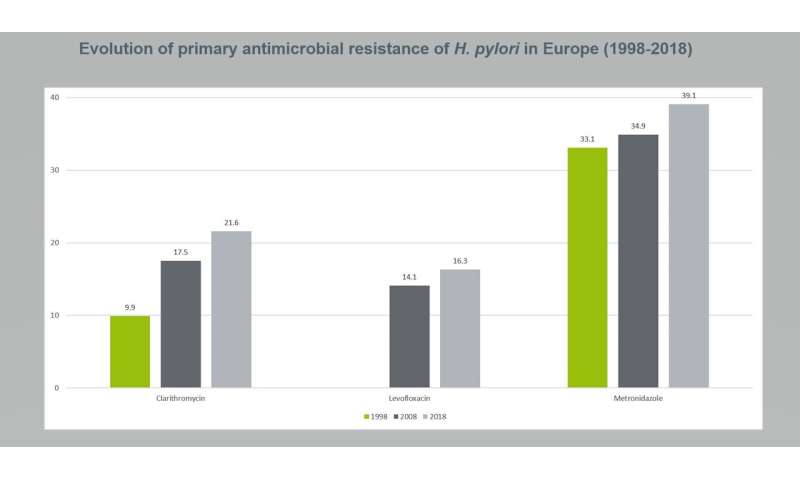Resistance to antibiotics doubles in 20 years, new study finds

Resistance to commonly-used antibiotics for treating harmful bacteria related to a variety of stomach conditions has more than doubled in 20 years, new research presented today at UEG Week Barcelona 2019 has shown.
The study, which analysed 1,232 patients from 18 countries across Europe, investigated resistance to antibiotics regularly taken for Helicobacter pylori (H. pylori) infection, a harmful bacterium associated with gastric ulcer, lymphoma and gastric cancer. Resistance to clarithromycin, one of the most established antimicrobials used to eradicate H. pylori, had increased from 9.9% in 1998 to 21.6% last year, with increases in resistance also seen for levofloxacin and metronidazole.
Antibiotic resistance occurs when bacteria develop the ability to survive exposure to medications designed to kill or halt their growth. It is one of the greatest threats to global health today, causing more than 750,000 deaths every year and, without urgent action, this number is expected to rise dramatically in the future.
Presenting the study today, lead researcher Professor Francis Megraud, explained, “H. pylori infection is already a complex condition to treat, requiring a combination of medications. With resistance rates to commonly used antibiotics such as clarithromycin increasing at an alarming rate of nearly 1% per year, treatment options for H. pylori will become progressively limited and ineffective if novel treatment strategies remain undeveloped. The reduced efficacy of current therapies could maintain the high incidence rates of gastric cancer and other conditions such as peptic ulcer disease, if drug resistance continues to increase at this pace.”
H. pylori is one of the most common bacterial infections in humans and is estimated to be present in one-half of the world’s population. H. pylori leads to inflammation of the stomach lining, namely gastritis, which can result in peptic ulcers. H. pylori is also the most important risk factor for gastric cancer, the seventh leading cause of cancer death in Europe and the third worldwide. In recent years, H. pylori antibiotic resistance has become a prominent and urgent issue across the globe. Underlining the severity of the situation, in 2017, the World Health Organisation identified clarithromycin-resistant H. pylori as a high priority bacterium for antibiotic research and development.
The survey also found that the rates of primary clarithromycin resistance in H. pylori were highest in Southern Italy (39.9%), Croatia (34.6) and Greece (30%), aligning with previous reports that predict that both Italy and Greece will have the highest number of deaths due to antimicrobial resistance amongst EU members by 20507. The high levels of resistance exhibited in these countries has been attributed to the overconsumption of antibiotics for conditions including cold and flu, and a lack of institutional support for antibiotic resistance containment strategies.
“The findings of this study are certainly concerning, as H. pylori is the main cause of peptic disease and gastric cancer,” commented Mário Dinis-Ribeiro, President of the European Society of Gastrointestinal Endoscopy. “The increasing resistance of H. pylori to a number of commonly-used antibiotics may jeopardize prevention strategies.”
The rate of ‘primary’ clarithromycin resistance in H. pylori in Europe in 2018 (%) found in the study was:
- Southern Italy: 36.9
- Croatia: 34.6
- Greece: 30.0
- Poland: 28.5
- Bulgaria: 26.9
- Ireland: 25.6
- Austria: 23.5
- France: 22.5
- Germany: 22.2
- Portugal: 20.0
- Belgium: 17.4
- Spain: 17.1
- Slovenia: 16.0
- Lithuania: 13.0
- Netherlands:9.2
- Norway:8.9
- Latvia: 6.8
- Denmark: 5.0
Source: Read Full Article